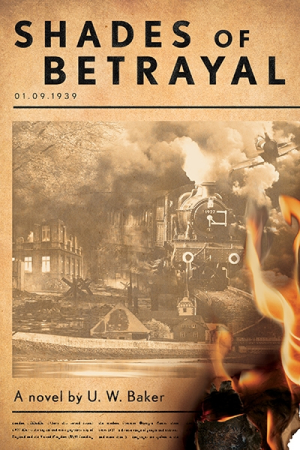
Shades of Betrayal
In the probing historical novel Shades of Betrayal, men’s virtues are tested by the atrocities of WWII.
U. W. Baker’s intricate historical novel Shades of Betrayal follows the difficulties and successes of people embroiled in WWII.
Ted became the head of his household at a young age after his father, Joseph, died while working in France. The proud citizen of a border town, he defends Polish freedom in covert WWII operations. When he finds out that his father might be alive, he begins questioning his truths.
Meanwhile, Erik, who is both Polish and German, becomes a German soldier; he falls in love with a Polish girl who works with Ted. And Billy is a British pilot who trained Polish forces at the beginning of the war; his plane crashes in France, and Ted’s half-brother, Joey, rescues him. These men’s paths overlap because of their families, too, and through love affairs.
Balancing action scenes with instances of reflection and historical overviews, the book’s three portions are tense. The first concentrates on background information, constructing the central men in terms of how their pasts shaped them. Ted’s seriousness is attributed to the fact that he had to lead his family; he is off-putting as a result. Billy nurses anger after his girlfriend betrays him; this bleeds into his work as a pilot. And Erik, who feels loyal to both sides of his family, ends up in danger because of this; he shares military information. Even the book’s women, who are secondary characters, are constructed in formidable terms: they act as spies and pry information from men with silken words and strategic gestures.
The book’s second portion zooms out from the men somewhat to cover historical events more broadly, including civilian involvement in war efforts. Its departures from the men’s stories alone enable it to cover general, but interesting, information from the war, as of women who scan photographs and serve in hospitals and factories. Letters are included; they become a means of conveying information, too, as people confess to one another, helping to bind their disparate stories together. The men’s story lines begin to intersect with one another’s in clearer ways.
Resolutions arrive in the book’s last third, which focuses on themes of forgiveness and reconciliation. There are tender, romantic moments and beautiful glimpses of Europe’s countryside, too. Reconsiderations of who one’s enemies are come in, and the men’s consciences are pricked; they rethink their attitudes toward others. Erik debates following orders he doesn’t believe in and works to protect the woman he loves. Still, despite this continual suspense, the dialogue holds the audience at a distance. People often use code names and passwords during covert operations, or relay information to one another in a stilted, out of place manner.
In the probing historical novel Shades of Betrayal, men’s virtues are tested by the atrocities of WWII.
Reviewed by
Mari Carlson
Disclosure: This article is not an endorsement, but a review. The publisher of this book provided free copies of the book and paid a small fee to have their book reviewed by a professional reviewer. Foreword Reviews and Clarion Reviews make no guarantee that the publisher will receive a positive review. Foreword Magazine, Inc. is disclosing this in accordance with the Federal Trade Commission’s 16 CFR, Part 255.
